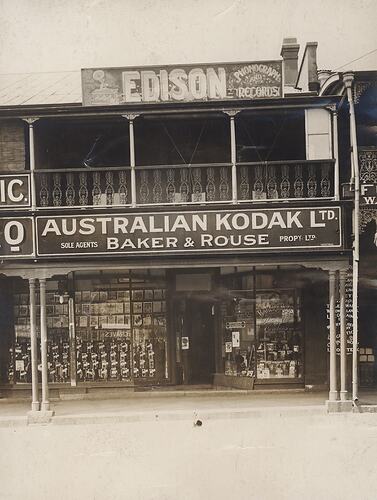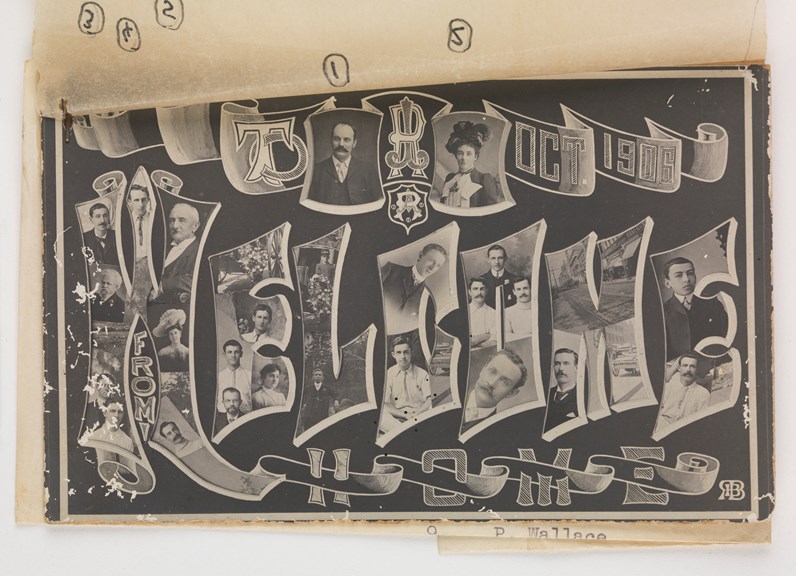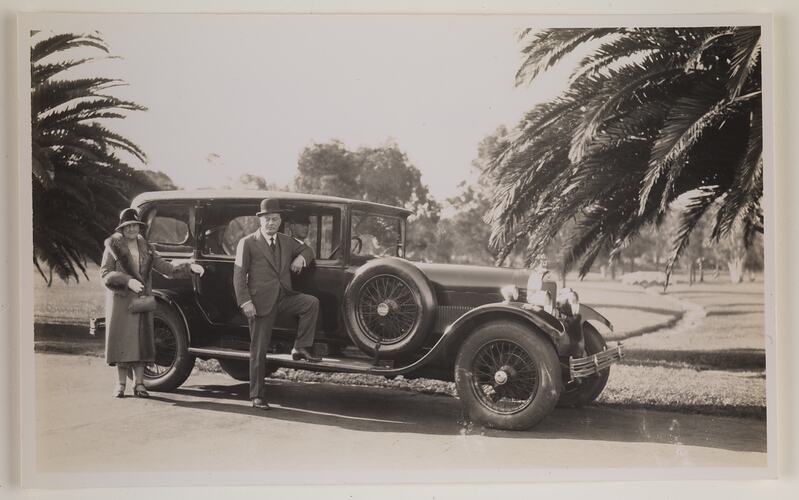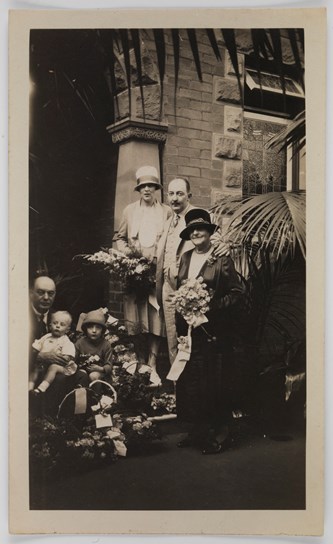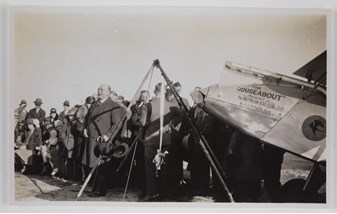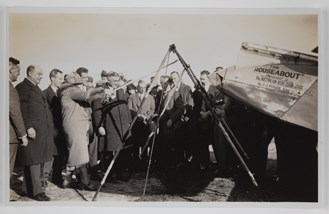
John Joseph Rouse
Retailer, Entrepreneur, Philanthropist
John Joseph (JJ) Rouse (1862–1938) made a name for himself in Australasia as a hugely successful photographic retailer – and also as a generous philanthropist.
Born in Melbourne in 1862, JJ Rouse was an enthusiastic amateur photographer who had a flair for marketing, and he went on to build an Australasian retail network in the photographic industry, that he directed for 61 years.
A Photography Enthusiast
JJ Rouse was educated in Melbourne before moving to Sydney as a young man. Interested in photography, he became a founding member of the Photographic Society of New South Wales.
In July 1885 he won third prize in the Society’s competition Class A for Three Landscapes, and also came third in Class B for Two Landscapes.
This hobby led him to a life-long career in the photographic industry.
Photography Salesman
Rouse first found work as a photographic salesman at JW Small Photographic Company in Sydney. He later joined Lichtner & Company, who sent him back to his home-town Melbourne in 1886 to manage their wholesale and retail stores.
While in Melbourne, JJ Rouse continued his photography hobby. He was involved in the Amateur Photographic Society of Victoria, and in 1887 was noted as a principal exhibitor at the society’s annual exhibition.
In March 1887, the Lichtner store where Rouse was based, at 37 Collins St East, started advertising the sale of Thomas Baker’s dry plates. Two months later, JJ Rouse & Thomas Baker bought out the Lichtner store, and opened their own photographic business, Baker & Rouse.
It was reported that in the early days of the business JJ Rouse had been too tired to go home so he sometimes slept upstairs in the studio attached to the shop.
Baker & Rouse
Baker & Rouse became a household name in Australasia over the next few decades.
JJ Rouse and Thomas Baker had a remarkable working relationship that endured for 41 years – and brought them both great wealth and influence.
In 1908 their business merged with Eastman Kodak to form an Australian Kodak subsidiary, which the two men remained managing directors of until they died.
Married in Melbourne
While building up the Baker & Rouse business in Melbourne, JJ met Anna Elsdon, and they married in June 1890. Thomas and Alice Baker gave them a large dining room clock as a wedding present, and the couple honeymooned in Sydney.
In 1891, JJ opened a Sydney branch of Baker & Rouse, and in 1892 he and Anna moved permanently to Sydney. JJ managed the Baker & Rouse retail and marketing business from here for the rest of his career.
Family Life in Sydney
Between 1892 and 1902, the Rouses lived at 'Queenscliffe', a large Victorian Italianate style villa house in Darling Point, Sydney. The house had ten rooms and a desirable harbour view.
The couple had three children, Marjorie, born in 1893, Edgar born in 1894 and Winifred born in 1898. All were born at home at Queenscliffe.
In 1900 the family moved around the corner to 'Yaralla' in Yarranabbe Road until 1908, when they moved to Kardinia, the house they built in Darling Point.
JJ Rouse lived at Kardinia for the rest of his life.
A Well-Loved Personality
JJ Rouse was respected and appreciated by his staff, as well as the broader photographic community, and he received a number of presentations honoring him.
In 1906 he and his wife were presented with a commemorative photographic postcard, welcoming them home from their first big trip to North America and England.
In 1909 he was presented with an illuminated address by the Australian Kodak Limited staff in Sydney, while in 1917 he was presented with a souvenir commemorating his connection with the Photographic Association of Victoria.
A Successful Life
After all of his hard work building up Baker & Rouse and then Kodak Australasia, JJ Rouse was able to enjoy the comfortable life that came with being a wealthy man.
At home at Kardinia, he and his family had a number of servants, including a house parlour maid, general servant, cook, and laundress.
He and his wife also had a limousine and driver.
A World of Travel
JJ Rouse was a well-travelled man. While this was mostly for Kodak business, and often involved touring around Australia or to New Zealand regularly, he also travelled abroad at least six times during his life.
Overseas voyages were invariably at least several months long. Sometimes JJ’s wife Anna accompanied him and they incorporated a holiday into the trip. When overseas, they took the opportunity to visit their daughter Marjorie, who now lived in America. On one of his trips, in 1926, JJ travelled to England, Europe and America with Anna for a 12-month business and leisure trip.
“This was taken by the Matson photographer the day we left San Francisco. It’s so very thrilling.”Anna wrote on the back of this image (below left)
A Society Man
By the 1890s, JJ Rouse, through his success in commerce and his sociable personality, was rising to become part of Sydney’s elite society.
Rouse moved in a circle of rich and influential people, including Sir Samuel Hordern and Sir James Fairfax, whom he socialised with during yacht club races and dinners, and other events on the Sydney social calendar.
He involved himself in a wide variety of social activities and organisations popular with the wealthy, leisured class at this time, and was welcomed by the established Sydney society as his personal wealth, business reputation and social standing increased.
Cars, Yachts and Planes
In the late nineteenth and early twentieth century Rouse pursued his love of cars, yachts and planes. He was a member and on the committees of numerous clubs relating to these pastimes in both New South Wales and Victoria.
These included the Automobile Club of Australia, Royal Yacht Club in Melbourne, Prince Alfred Yacht Club in Sydney, and the Royal Aero Club of NSW.
A Civic Mind
JJ Rouse may have lived well, but he also devoted himself to many civic causes.
He was a foundation member and leader of various charities and organisations seeking public progress, including the Sunshine Club and the Millions Club.
At the time of his death Rouse was the vice-president of the Civic Reform Association, chairman of Eagle Star Insurance, and Life Governor of several hospitals.
Highlighting his influential status in society and his commitment to having an impact in public life, and probably also reflecting his executive role at Kodak, which had an American parent company, in 1926 JJ Rouse was part of a delegation from Australia who went to the White House in America. The group presented President Coolidge with a painting of the American fleet entering Sydney Harbour in 1925, as a mark of international relations.

A Philanthropist
JJ Rouse used his wealth and influence to make a difference in society.
He gave to those less fortunate, with a focus on children and hospitals. For instance, in 1930 he gave 500 pounds to a new Children’s Mission.
He was the benefactor of numerous hospitals, including through his will which left £200 each to Royal Prince Alfred, Sydney Hospital, Royal North Shore, St. Vincent's, and the Women's Hospital, Crown Street.
After Thomas Baker died, JJ Rouse was the Chairman of Trustees for the Baker Institute for Medical Research.
In 1928 JJ Rouse donated an aeroplane for training pilots to the Royal Aero Club of NSW. It was christened the ‘Rouseabout’.
Death
"“Another of Australia’s Grand Old Men of Photography Has Passed On.”Australasian Photographic Review, 1938
John Joseph ‘JJ’ Rouse died at home at Kardinia on 7 September 1938, aged 77 years.
He had continued working for Kodak Australasia, right up until the end of his life.
The Australasian Photo-Review, which JJ Rouse’s company, Kodak Australasia, published, noted that “the names of Mr J.J. Rouse and Photography have been synonymous for over fifty years”.
References
Age, 8 September 1938, p.12
Argus, 28 July 1887, p.11
Australasian, 28 June 1890, p.38
Australasian Photo-Review, 22 July 1909, p.385-386; 1 Sep 1938 not paginated
Daily Telegraph, 17 December 1926, p. 9; 7 December 1938, p. 5; 11 September 1918, p.8
New York Times, 21 November 1926, p.7
Referee, 13 December 1911, p.10
Register, Tuesday 23 October 1906, p.3
Rouse family
Scrutineer and Berrima District Press, 25 June 1930, p.2
Sun, 7 September 1938, p.11
Sydney Morning Herald, 16 December 1937, p.3; 15 July 1885, p. 7




